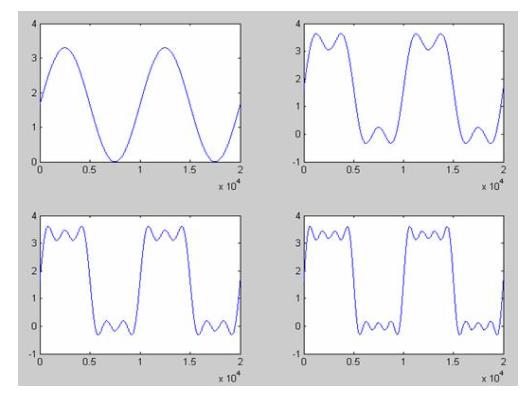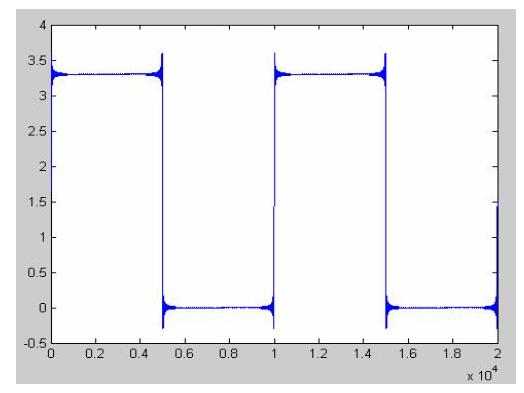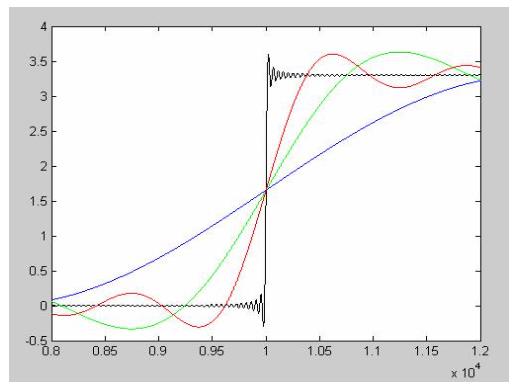I mentioned in the previous article that we should pay attention to the signal rise time. Many signal integrity problems are caused by the short signal rise time. This article will talk about a basic concept: the relationship between signal rise time and signal bandwidth.
For digital circuits, the output is usually a square wave signal. The rising edge of the square wave is very steep. According to Fourier analysis, any signal can be decomposed into a series of sinusoidal signals of different frequencies. The square wave contains very rich spectral components.
Putting aside the boring theoretical analysis, we use experiments to intuitively analyze the frequency components in the square wave and see how sine signals of different frequencies are superimposed into a square wave. First, we superimpose a 1.65v DC and a 100MHz sine wave to get a single frequency sine wave with a DC offset of 1.65v. We superimpose a sinusoidal signal with an integer multiple of frequency on this signal, which is commonly referred to as harmonics. The frequency of the 3rd harmonic is 300MHz, the frequency of the 5th harmonic is 500MHz, and so on, the higher harmonics are all integer multiples of 100MHz. Figure 1 is a comparison before and after superimposing different harmonics. The upper left corner is the 100MHz fundamental frequency waveform with DC offset, and the upper right corner is the waveform after the fundamental frequency is superimposed with the third harmonic, which is a bit similar to a square wave. The bottom left corner is the waveform of fundamental frequency + 3rd harmonic + 5th harmonic, and the lower right corner is the waveform of fundamental frequency + 3rd harmonic + 5th harmonic + 7th harmonic. It can be seen intuitively that the more harmonic components are superimposed, the more the waveform resembles a square wave.
figure 1

Therefore, if enough harmonics are superimposed, we can synthesize a square wave approximately. Figure 2 is the waveform superimposed on the 217th harmonic. It is already very similar to the square wave. Don't care about the burrs on the corners. It is the famous Gibbs phenomenon. This kind of simulation is bound to happen, but it does not affect the understanding of the problem. Here we have the highest frequency of superimposed harmonics up to 21.7GHz.
figure 2

The above experiment is very helpful for us to understand the essential characteristics of the square wave waveform. An ideal square wave signal contains an infinite number of harmonic components. It can be said that the bandwidth is infinite. There is a gap between the actual square wave signal and the ideal square wave signal, but there is one thing in common, that is, it contains high frequency spectrum components.
Now we look at the effect of superimposing different spectral components on the rising edge. Figure 3 is a comparative display. The blue is the rising edge of the fundamental frequency signal, the green is the rising edge of the waveform after the 3rd harmonic is superimposed, the red is the rising edge after the fundamental frequency + the 3rd harmonic + the 5th harmonic + the 7th harmonic, and the black one is It is superimposed to the rising edge of the waveform after the 217th harmonic.
Figure 3

Through this experiment, it can be seen intuitively that the more harmonic components, the steeper the rising edge. Or from another perspective, if the rising edge of the signal is steep and the rise time is short, then the bandwidth of the signal is very wide. The shorter the rise time, the wider the bandwidth of the signal. This is a very important concept, you must have an intuitive understanding, deep in your mind, it is very good for you to learn signal integrity.
Here to talk about, the final synthesized square wave, its waveform repetition frequency is 100MHz. Superimposing harmonics only changes the signal rise time. The signal rise time has nothing to do with the frequency of 100MHz, and it is the same rule when changing to 50MHz. If the output data signal of your circuit board is only tens of MHz, you may not care about signal integrity issues. But now you think about the impact of the high frequency harmonics in the spectrum due to the short rise time of the signal? Remember an important conclusion: it is not the repetition frequency of the waveform that affects signal integrity, but the rise time of the signal.
The simulation code of this article is very simple, I will post the code here, you can run it on matlab by yourself.
clc; clear all; pack;
Fs = 10e9;
Nsamp = 2e4;
t = [0:Nsamp-1].*(1/Fs);
f1 = 1e6;
x0 = 3.3/2;
x1 = x0 + 1.65*sin(2*pi*f1*t);
x3 = x0;
for n=1:2:3
x3 = x3 + 3.3*2/(pi*n) * sin(2*pi*n*f1*t);
end
x5 = x0;
for n=1:2:5
x5 = x5 + 3.3*2/(pi*n) * sin(2*pi*n*f1*t);
end
x7 = x0;
for n=1:2:7
x7 = x7 + 3.3*2/(pi*n) * sin(2*pi*n*f1*t);
end
figure
subplot(221)
plot(x1)
subplot(222)
plot(x3)
subplot(223)
plot(x5)
subplot(224)
plot(x7)
x217 = x0;
for n=1:2:217
x217 = x217 + 3.3*2/(pi*n) * sin(2*pi*n*f1*t);
end
figure
plot(x217)
figure
plot(x217,'k')
hold on
plot(x1,'b')
plot(x3,'g')
plot(x7,'r')
hold off
axis([8000 12000 -0.5 4])